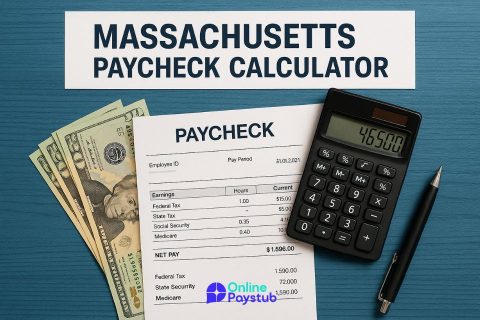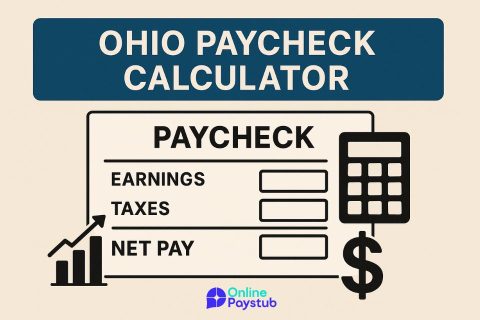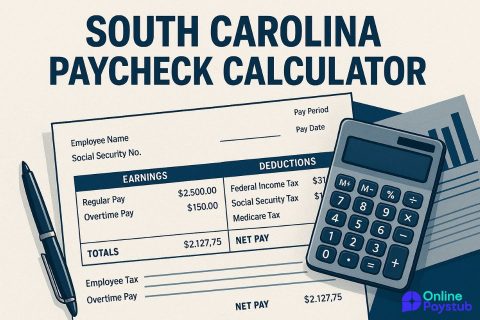California paychecks reflect more than just your agreed salary or hourly wage; they encapsulate a layered structure of mandatory taxes, benefit deductions, and federal adjustments. Anyone working in California, whether hourly or salaried, will notice a distinct gap between gross pay and take-home earnings. This gap is due to a combination of state-specific rules, such as progressive income tax rates and required contributions like State Disability Insurance.
In California, understanding how your paycheck is structured isn’t just about awareness it’s essential for financial planning. With some of the nation’s highest income tax rates and unique local regulations, even small paycheck adjustments can make a notable difference in your monthly budgeting.
Your gross earnings begin with your base wage, but what ultimately lands in your bank account is shaped by a sequence of withholdings: federal income tax, Social Security and Medicare (FICA), and California-specific deductions. Beyond these, voluntary deductions such as retirement contributions or health insurance premiums also come into play. The result is a net amount that may differ substantially from your initial expectations if you’re not familiar with how California’s system operates.
What Is a California Paycheck Calculator and Why Should You Use One?
California paycheck calculator is a digital tool designed to estimate how much of your income remains after taxes and deductions specific to the state. It helps employees understand their expected take-home pay by incorporating various factors, including income type, pay frequency, filing status, and voluntary benefits contributions.
Unlike a simple gross-to-net formula, this calculator accounts for both federal and California-specific taxes. These include State Disability Insurance, Paid Family Leave contributions, and adjustments for Social Security and Medicare. For individuals with multiple income streams or changing financial situations, such a tool becomes indispensable.
Using a calculator before accepting a job offer or negotiating a salary can offer clarity. It helps estimate how much of an annual salary translates into real, usable income across different pay periods. By adjusting input values like marital status, number of dependents, or pre-tax deductions, users can explore various scenarios and prepare for tax implications more confidently.
How Is Take-Home Pay Calculated in California?
Take-home pay in California is determined by subtracting required taxes and deductions from gross earnings. While the calculation may seem straightforward at first glance, California’s layered tax structure and mandatory contributions introduce complexity that can significantly influence the final amount.
The process starts with identifying the gross pay. This figure reflects either an annual salary or hourly wage multiplied by the number of hours worked within a pay period. From this total, federal taxes are withheld, including income tax, Social Security at 6.2 percent, and Medicare at 1.45 percent. If income exceeds specific thresholds, an additional 0.9 percent Medicare surtax applies.
Following federal withholdings, California state income tax is calculated. The state uses a progressive tax system with ten income brackets ranging from 1 to 13.3 percent. Higher earners fall into higher brackets, resulting in larger deductions from each paycheck. In addition, California mandates State Disability Insurance contributions at 1.1 percent, with no income cap since 2024.
Other deductions can also apply. These include pre-tax contributions to retirement plans like 401(k)s or health-related accounts such as HSAs. Employers may also withhold funds for health insurance premiums or union dues, depending on the employee’s benefits package and employment agreement.
Pay frequency has a notable impact as well. An employee paid weekly will see smaller but more frequent deductions than someone paid monthly, though the annual totals align. The timing of deductions and tax brackets in shorter pay cycles can influence how each paycheck is distributed.
Ultimately, take-home pay is the result of federal, state, and optional deductions acting upon gross earnings. Employees who understand how these variables interact are better equipped to manage budgeting, savings, and long-term financial planning.
Federal vs. California Payroll Taxes
Federal and California payroll taxes serve different purposes and are calculated using separate systems. While both reduce gross pay, their structures, rates, and covered programs vary significantly.
Federal payroll taxes include income tax, Social Security, and Medicare. The income tax rate depends on the filing status and taxable income, following a progressive system. Social Security is taxed at 6.2 percent on earnings up to a federal wage base limit, and Medicare is taxed at 1.45 percent without a cap. High earners may also be subject to an additional Medicare tax of 0.9 percent once income surpasses federal thresholds.
California’s payroll tax system operates independently of federal requirements. The state applies its own progressive income tax structure, with ten tax brackets ranging from 1 percent to 13.3 percent. The highest rate applies only to income exceeding one million dollars for single filers. In addition to income tax, employees contribute to State Disability Insurance at a flat rate of 1.1 percent on all wages, with no income cap as of 2024. There are also potential deductions for Paid Family Leave and, in some cases, unemployment insurance.
Another key difference is that while federal tax rates are consistent across all states, California’s rates and rules apply only to income earned in the state. This becomes particularly relevant for those who live in one state but work in California or vice versa.
Employers are also involved in both systems. For federal taxes, they must match employee contributions to Social Security and Medicare. In California, employers fund other state-specific programs, though some payroll costs are shared with employees depending on the situation.
Breakdown of Mandatory Deductions in California Paychecks
Mandatory deductions in California are applied to every paycheck and directly reduce the employee’s take-home pay. These withholdings are governed by federal and state regulations and are not optional for most workers.
The primary federal deductions include:
- Federal Income Tax: Withheld based on income level, filing status, and information provided on IRS Form W-4.
- Social Security Tax: Set at 6.2 percent of wages, capped at a federal wage base limit.
- Medicare Tax: 1.45 percent of all wages, with an additional 0.9 percent for high earners.
At the state level, California imposes its own deductions:
- State Income Tax: Based on a progressive rate structure, ranging from 1 percent to 13.3 percent. Filing status and income level determine the applicable bracket.
- State Disability Insurance (SDI): Deducted at a rate of 1.1 percent from all taxable wages with no cap as of 2024. This fund provides wage replacement in cases of short-term disability.
- California Paid Family Leave (PFL): Funded through SDI, it allows eligible workers to take time off to care for a family member or bond with a new child.
In addition to these standard deductions, some workers may also see:
- Unemployment Insurance (UI): Though primarily an employer-paid tax, certain workers (such as those in unionized sectors) may see a partial deduction.
- Training Tax: In limited cases, California employers contribute to a fund designed to support workforce development, though this typically does not affect employees directly.
The Role of State Disability Insurance (SDI) in Your Net Pay
State Disability Insurance, or SDI, is a mandatory payroll deduction in California that directly impacts net pay. This program is designed to provide partial wage replacement for workers who are temporarily unable to work due to a non-work-related illness, injury, or pregnancy. It also funds Paid Family Leave benefits for eligible employees.
The SDI rate is set annually by the California Employment Development Department (EDD). As of 2024, the contribution rate is 1.1 percent, and recent legislation has removed the cap on taxable wages, meaning high earners now contribute a greater dollar amount than in previous years.
This deduction appears as a line item on every paycheck issued to employees covered by California unemployment insurance laws. For a salaried employee earning $100,000 per year, SDI contributions would total $1,100 annually. For someone with a higher income, the amount scales accordingly, given the removal of the wage limit.
While SDI reduces take-home pay, it functions as a form of income protection. Should an employee need to take time off due to a qualifying medical condition, the benefit helps offset lost wages during that period. Applications for SDI benefits are processed by the EDD, and payments are calculated based on the claimant’s previous earnings.
How Paid Family Leave Contributions Impact Your Salary
Paid Family Leave (PFL) in California is funded through the State Disability Insurance program and is not a separate line item on a paycheck. Still, it affects net salary by extending the scope of SDI contributions. When employees pay into SDI, they are also funding their eligibility for PFL benefits.
PFL provides partial wage replacement to employees who take time off to care for a seriously ill family member or to bond with a new child. The benefit is available for up to eight weeks within a twelve-month period and is calculated based on a percentage of the employee’s previous earnings. Because this program is tied to SDI, no additional deduction is made specifically for PFL—it is covered under the existing SDI rate of 1.1 percent.
Although this may seem like a small deduction, over time it adds up, particularly for those in higher income brackets. For example, an employee earning $120,000 annually would contribute $1,320 per year toward SDI, a portion of which supports PFL. While this reduces take-home pay slightly each month, it provides financial relief in situations where income would otherwise stop due to family care responsibilities.
Eligibility for PFL is based on the employee’s work history and wage level during a defined base period. The benefit is not job-protected by itself, but it often runs concurrently with job-protected leave such as the California Family Rights Act or federal Family and Medical Leave Act.
Pre-Tax vs. Post-Tax Deductions
Every paycheck issued in California may include both pre-tax and post-tax deductions, each affecting net income differently. Understanding how these deductions work helps employees make informed decisions about benefits and withholding strategies.
Pre-tax deductions are subtracted from gross pay before taxes are calculated. This reduces taxable income, lowering the amount withheld for federal and state income taxes as well as FICA contributions. Common pre-tax deductions include:
- Health insurance premiums
- 401(k) retirement contributions
- Health Savings Accounts (HSA)
- Flexible Spending Accounts (FSA)
- Commuter benefits
Because these deductions lower taxable income, they effectively increase take-home pay compared to receiving the same benefits on a post-tax basis. For example, contributing $200 monthly to a 401(k) plan means that $200 is not subject to federal or California income tax for that period.
Post-tax deductions, on the other hand, are taken out after all applicable taxes have been withheld. These do not reduce taxable income but may be necessary for certain types of benefits or voluntary programs. Examples include:
- Roth 401(k) contributions
- Union dues not exempt under tax law
- Charitable contributions
- Wage garnishments
- Life insurance (depending on the structure)
Post-tax deductions do not affect how much tax is owed but do reduce the final amount deposited into the employee’s account.
Choosing between pre-tax and post-tax options often involves evaluating long-term financial goals. Pre-tax deductions may provide immediate tax savings, while post-tax contributions can offer advantages like tax-free withdrawals in retirement, as with Roth accounts.
Employees should review their pay stubs regularly to understand how these deductions appear and to verify that elected contributions are being processed correctly. Even small errors in classification can impact annual tax liability or benefit eligibility.
Best Tools to Estimate California Take-Home Pay Accurately
Accurately estimating take-home pay in California requires more than a simple deduction of taxes. A reliable tool must account for federal and state tax brackets, mandatory contributions such as State Disability Insurance, and variables like pay frequency, filing status, and benefit elections. While several online calculators claim to offer precise estimations, not all are equipped to reflect the complexity of California’s payroll system.
Among available options, Online Pay Stub stands out as one of the most comprehensive and practical tools for this purpose. Unlike basic calculators that offer only general estimates, Online Pay Stub allows users to input detailed parameters, including:
- Pay type (hourly or salaried)
- Federal and state withholding status
- Pre-tax and post-tax deductions
- Overtime, bonuses, and other supplemental wages
- Pay frequency and filing status
- Multi-job or dual-income scenarios
This level of detail enables more accurate forecasting of take-home pay across varying income levels and employment types. In addition, Online Pay Stub reflects California-specific tax regulations, including the uncapped SDI contribution and current income tax brackets. Users can also simulate how benefit changes or withholding adjustments would impact their paychecks over time.
What makes Online Pay Stub especially effective is its alignment with actual payroll processing practices. It mirrors the fields used in real payroll systems, allowing users to see a clear breakdown of gross pay, taxes, and deductions, similar to what they would find on an official pay stub. This transparency helps with budgeting, tax planning, and benefits evaluation.




No comments to show.